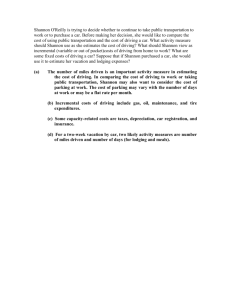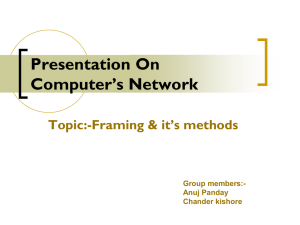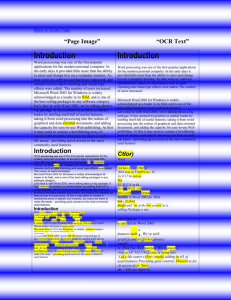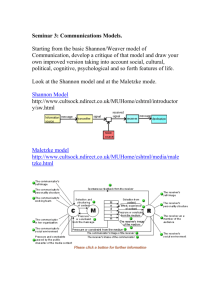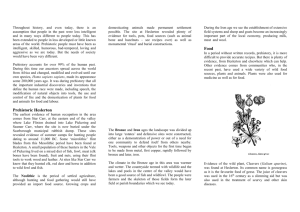bit stuffing and applications to constrained codes - dimacs
advertisement
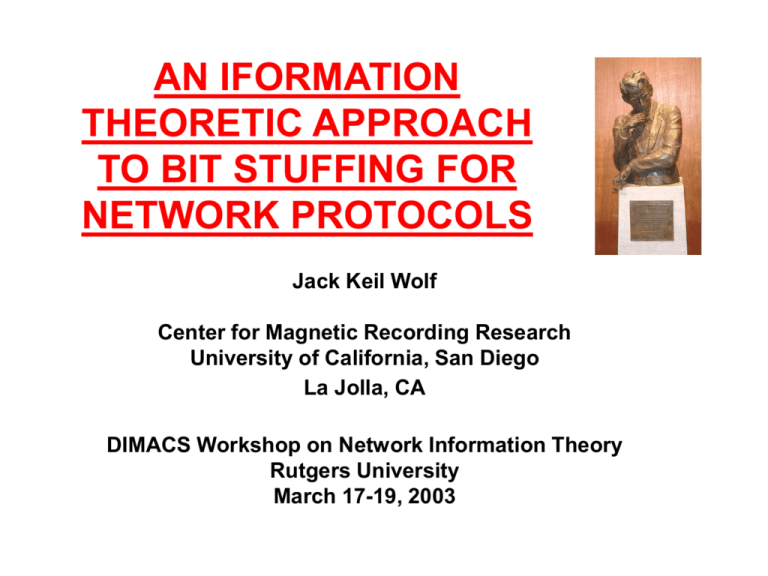
AN IFORMATION
THEORETIC APPROACH
TO BIT STUFFING FOR
NETWORK PROTOCOLS
Jack Keil Wolf
Center for Magnetic Recording Research
University of California, San Diego
La Jolla, CA
DIMACS Workshop on Network Information Theory
Rutgers University
March 17-19, 2003
Acknowledgement
• Some of this work was done jointly with:
Patrick Lee
Paul Bender
Sharon Aviran
Jiangxin Chen
Shirley Halevy (Technion)
Paul Siegel
Ron Roth (Technion)
Constrained Sequences and
Network protocols
• In many protocols, specific data patterns are
used as control signals.
• These prohibited patterns must be prevented
from occurring in the data.
• In any coding scheme that prohibits certain
patterns from occurring, the number of
constrained (or coded) bits must exceed
the number of data bits.
Relationship to Information
Theory
• The average number of data bits per
constrained bit is called the rate of the
code.
• The Shannon capacity is the maximum rate
of any code.
• Practical codes usually have rates
strictly less than the Shannon capacity.
Bit Stuffing
• Bit stuffing is one coding technique for
preventing patterns from occurring in
data.
• The code rate for bit stuffing is always less
than the Shannon capacity.
• Here we show how to make the code rate for
bit stuffing equal to the Shannon
capacity.
Bit Stuffing and Protocols
• Definition from Webopedia:
(http://www.webopedia.com/TERM/B/bit_stuffing.html)
“bit stuffing-The practice of adding bits to a stream of data. Bit
stuffing is used by many network and communication
protocols for the following reasons: To prevent data being
interpreted as control information. For example, many framebased protocols, such as X.25, signal the beginning and end of
a frame with six consecutive 1’s. Therefore, if the actual data
has six consecutive 1 bits in a row, a zero is inserted after the
first 5 bits… Of course, on the receiving end, the stuffed bits
must be discarded…”
data:
01111110111110101010…
This won’t work:
transmit:
011111010111110101010…
But this will:
transmit:
0111110101111100101010…
A Diversion: Binary (d,k)
Constrained Sequences
• The X.25 constraint is a special case of a binary (d,k)
constraint used in digital storage systems.
• Such binary sequences have at least d and at most k 0’s
between adjacent 1’s.
•
For d > 0 and finite k, the sequences are produced by the
edge labels when taking tours of the graph:
0
0
1
0
…
0
d-1
0
0
d
1
0
d+1
1
…
0
k-1
1
0
k
1
Binary (0, k) Constrained
Sequences
• For d=0 and finite k, allowable sequences are
produced by the edge labels of the graph:
1
0
0
0
1
0
2
1
1
0
k-1
1
0
k
1
Binary (d, ∞) Constrained
Sequences
• For infinite k, the sequences are produced by the
edge labels when touring the graph:
0
0
1
0
0
2
0
d-1
0
0
d
1
Back to Protocols
• By complementing the bits in a (0,5) code, we
will produce sequences that have no
more than 5 consecutive 1’s.
• Thus, after complementing the bits, any (0,5)
code can be used in the X25 protocol.
Bit Stuffing
• In this talk we will investigate the code rates which can be
achieved with bit stuffing and compare these rates with the
Shannon capacity.
• We will use as our constraint, binary (d,k) codes, although our
technique applies to a much wider class of codes.
• We will begin with plain vanilla bit stuffing which gives rates
strictly less than capacity.
• Then we show how bit stuffing can be modified to yield rates
equal to capacity for some values of d and k.
• Finally we show how bit stuffing can be further modified to
yield rates equal to capacity for all values of d and k.
Bit Stuffing for (d,k) Codes
• For any value of d and k (0 < d < k), one can use bit
stuffing to form sequences that satisfy the
constraint.
• The bit stuffing encoding rule is:
Step 1. If last bit is a 1, stuff d 0’s. Go to next
step. (Skip this step if d=0.)
Step 2. If last k bits are 0’s stuff a 1. Return
to first step. (Skip this step if k=∞.)
0
0
1
0
… 0
d-1
0
0
d
1
0
d+1
1
…
0
k-1
1
0
k
1
Rate for Bit Stuffing vs Shannon
Capacity of (d,k) Codes
• The rate for bit stuffing is the average number of
information bits per transmitted symbol.
• The rate here is computed for i.i.d. binary data with
equally likely 0’s and 1’s.
• The Shannon capacity of a (d,k) constrained
sequence is the maximum rate of any
encoder-decoder that satisfies the constraint.
• Therefore the rate for bit stuffing is less than or
equal to the Shannon capacity of the constraint.
Shannon Capacity of a (d,k)
Constraint
• Define N(n) as the number of distinct binary
sequences of length n that satisfy the constraint.
• Then, for every 0 < d < k,
log[ N (n)]
C lim
n
n
exists and is called the Shannon capacity of the
code.
Shannon Capacity
• Shannon (1948) gave several methods for computing
the capacity of (d,k) codes.
• For finite k, he showed that the following difference
equation describes the growth of N(n) with n:
N(n)=N(n-(d+1))+N(n-(d+2))+ … +N(n-(k+1)).
• By solving this difference equation, Shannon
showed that the capacity, C = C(d,k), is equal to
the base 2 logarithm of the largest real root of
the equation:
xk+2 - xk+1 - xk-d+1 +1 = 0.
Bit Stuffing and Shannon
Capacity
• If one uses bit stuffing on uncoded data, except for `
the trivial case of (d=0, k=∞), the rate always is
strictly less than the Shannon capacity.
• The rate here is computed for i.i.d. binary data with
equally likely 0’s and 1’s.
• But by a modification to bit stuffing, using a
distribution transformer, we can improve the
rate and sometimes achieve capacity.
Slight Modification to Bit Stuffing
• A distribution transformer converts the binary data
sequence into an i.i.d. binary sequence that is pbiased for 0 < p < 1. The probability of a 1 in this
biased stream is equal to p.
• The distribution transformer can be implemented by
a source decoder for a p-biased stream.
• The conversion occurs at a rate penalty h(p), where
h(p) = -plog(p)-(1-p)log(1-p).
• We can choose p to maximize the code rate and
sometimes achieve capacity.
Bit Stuffing with Distribution
Transformer
½
½
01001…
010011100101 …
Distribution
Transformer
p-Bias
1-p p
Distribution
Transformer
p-Bias
00110…
Bit Stuffer
1000110000000 ...
10001010000010000 …
Inverse
Distribution
Transformer
Bit Unstuffer
10001010000010000 …
n
h( p )
1000110000000 ...
010011100101 …
Slight Modification to Bit Stuffing
• As shown by Bender and Wolf, after optimizing p,
the code rate can be made equal to the
Shannon capacity for the cases of (d, d+1) and
(d,∞), sequences for every d > 0.
• However, even after choosing the optimum value of
p, the code rate is strictly less than the
Shannon capacity for all other values of d and k.
Code Rate vs. p (B&W)
Code Rate vs Bias Parameter p
0.8
0.7
0.5
0.4
0.3
0.2
0.1
0.0
Bias Parameter p
0
0.5
1.0
Average Rate
0.6
(1, 3, ∞)
(1, 7, ∞)
(2, 7, ∞)
Code Rate/Capacity vs k for
Fixed d: Optimum p (B&W)
Relative Code Rate vs Parameter k
1.000
Average Rate/Capacity
0.995
(0, k, ∞)
0.990
(1, k, ∞)
(2, k, ∞)
(3, k, ∞)
(4, k, ∞)
(5, k, ∞)
0.985
0.980
0.975
1
3
5
7
9
11
13
15
17
Param eter k
19
21
23
25
27
29
Two Questions
• Why does this technique achieve
capacity only for the cases: k = d+1
and k = ∞?
• Is it possible to achieve capacity for
other cases?
• To answer these questions we make a
slight diversion.
A Further Diversion: Bit Stuffing
and 2-D Constraints
• Bit stuffing has been used to generate two
dimensional constrained arrays.
• Details of this work are in a series of papers, the
latest entitled “Improved Bit-Stuffing Bounds on
Two-Dimensional Constraints” which has been
submitted to the IEEE Transactions on
Information Theory by:
Shirley Halevy
Jiangxin Chen
Ron Roth
Paul Siegel
Me
Technion
UCSD
Technion
UCSD
UCSD
Two Dimensional Constraints
• Two dimensional constrained arrays can have applications in
page oriented storage.
• These arrays could be defined on different lattices. Commonly
used are the rectangular lattice and the hexagonal lattice.
• Example 1: Rectangular lattice with a (1, ∞) constraints on the
rows and columns:
0
0 1 0
0
• Example 2: Hexagonal lattice with a (1, ∞) constraints in 3
directions:
0 0
0 1 0
0 0
Capacity and Two Dimensional
Constrained Arrays
• Calculating the Shannon capacity for two
dimensional constrained arrays is largely an
open problem.
• The exact value of the capacity for the
rectangular (1, ∞) constraint is not known.
However, Baxter has obtained the exact value of
the capacity of the hexagonal (1, ∞) constraint.
• In some cases where the two dimensional capacity is
not known, we have used bit stuffing to obtain
tight lower bounds to the capacity.
Two Dimensional Bit Stuffing:
Rectangular Lattice with (1, ∞)
Constraint
• A distribution transformer is used to produce a pbiased sequence.
• The p-biased sequence is written on diagonals
• Every time a p-biased 1 is written, a 0 is inserted
(that is stuffed) to the right and below it.
• In writing the p-biased sequence on
diagonals, the positions in the array
containing stuffed 0’s are skipped.
Bit Stuffing and Two
Dimensional Constrained Arrays
• Suppose we wish to write the p-biased
sequence 01 02 03 14 05 06 17 08 …
01
06
08
02
03
17
07
14
05
07
04
04
“Double Stuffing” with the (1, ∞)
Constraint
• Sometimes a p-biased 1 results in only one stuffed 0
since there is already a stuffed 0 to the right of it.
• In writing the sequence 01 02 03 14 15 06 07 …,
15 results in only a single stuffed 0, since 14
having been written above and to the right of it,
already has written the other 0. That is, 04,5 is
a “double” stuffed 0.
01
03
06
07
02
15
05
14
04,5
04
Multiple p-Biased Transformers
• This suggests having two values for p: one, p0, for
the case where the bit above and to the right
of it is a 0 and the other, p1, when that bit is a 1.
• Doing this and optimizing we obtain:
p0= 0.328166
p1=0.433068
code rate=0.587277 (which is within 0.1% of
capacity)
• This suggests using multiple p’s in one dimension to
improve the code rate.
Shannon Capacity and Edge
Probabilities
• The maximum entropy (i.e., the capacity) of a
constraint graph induces probabilities on the
edges of the graph.
• For finite k, the Shannon capacity is achieved
when the edges of the graph are assigned the
probabilities as indicated below where C = log(l).
1-{l-(d+2) / (1-l-(d+1))}
1
0
1
1
1
2
1
(1-l-(d+1))
1
d-1
d
d+1
d+2
l-(d+1)
k
1
l-(d+2) / (1-l-(d+1))
Shannon Capacity and Edge
Probabilities
• And for the (d, ∞) constraint, the Shannon capacity is
achieved when the edges of the graph are
assigned the probabilities as indicated:
0
1
1
1
1
2
1
d-1
1
1-l-(d+1)
d
l-(d+1)
Why Bit Stuffing Sometimes
Achieved Capacity for B&W
• The graphs for the two cases of constraints that achieved
capacity are shown below :
1
1
1
1-l-(d+1)
1-l-(d+1)
l-(d+1)
(d,d+1) Constraint
1
l-(d+1)
1
(d, ∞) Constraint
• Note that for both graphs, only one state has two edges
emanating from it. Thus, only one bias suffices and the
optimum p for both cases is:
p= l-(d+1).
• For other values of d and k, there will be more than one state
with two exiting edges.
Capacity Achieving Bit Stuffing
• This suggests a better scheme which achieves
capacity for all values of d and k.
• For k finite, there are (k-d) states in the graph with
two protruding edges.
• The binary data stream is converted into (k-d) data
streams, each by a different distribution
transformer. The p’s of each of the transformers
are chosen to emulate the maxentropic edge
probabilities for the the (k-d) states with two
protruding edges.
Block Diagram of Encoder
Distribution
Transformer
pd-Bias
Distribution
Transformer
Pd+1-Bias
Smart
Mux
Distribution
Transformer
p(k-1)-Bias
Smart
DeMux
Bit Stuffer
Bit Stuffing with Average Rate
Equal to the Shannon Capacity
• Example: (1,3) Code
The maxentropic probabilities for the branches are:
1
0.5345
0.4655
0.4057
0.5943
Run Length Probabilities
1
Length
2
3
4
Probability
0.4655
0.3176
0.2167
Thus, one distribution transformer should have
p=0.4655 and the second distribution
transformer should have p=0.5943.
Bit Stuffing with Average Rate
Equal to the Shannon Capacity
• Example: (2,4) Code
The maxentropic probabilities for the branches are:
1
1
0.5699
0.4301
0.4301
0.5699
Run Length Probabilities
1
Length
3
4
5
Probability
0.4301
0.3247
0.2451
Thus, one distribution transformer should have
p=0.4301 and the second distribution
transformer should have p=0.5699. But only one
distribution transformer is needed. Why?
Bit Flipping and Bit Stuffing
• For the (2,4) case, one can use one distribution
transformer and bit flipping in conjunction with
bit stuffing to achieve capacity.
• For k finite, we next examine such a system for
arbitrary (d,k):
Distribution
Transformer
p-Bias
Controlled
Bit Flipper
Bit Stuffer
Questions
•
What is the optimal bit flipping position?
•
•
When can we improve the rate by bit flipping?
Can we achieve capacity for more constraints, using
bit flipping?
If not, how far from capacity are we?
•
1
0
1-p
1
1
...
1-p
d
d+1
p
p
1-p
??
...
1-p
p
p
...
1-p
p
k-1
k
1
Answers (Aviran)
•
•
•
For all (d,k) with d≥1, d+2≤k<∞ and p<0.5:
– the optimal flipping position is k-1.
For all (d,k) with d≥1, d+2≤k<∞:
– flipping improves the rate over original bit stuffing.
Capacity is achieved only for the (2,4) case.
1
0
1
1
1-p
...
1-p
1-p
d
d+1
p
p
...
1-p
k-2
p
p
k-1
1-p
k
1
Numerical Results
Constraint
(1,4)
(1,7)
(2,5)
(3,6)
(4,8)
(5,9)
Original
Algortihm
Average Rate
0.6103
0.6754
0.4579
0.368
0.3364
0.2914
Flipping
Algorithm
Average Rate
0.6157
0.6779
0.4638
0.373
0.3403
0.2946
Capacity
0.6175
0.6792
0.465
0.3746
0.3432
0.2978
Original Average
Rate/Capacity
98.83%
99.44%
98.47%
98.24%
98.02%
97.85%
Flipping Average
Rate/Capacity
99.71%
99.81%
99.74%
99.57%
99.16%
98.93%
Topics Missing From This
Talk
• A lot of interesting mathematics.
• Results for more general one and two dimensional
constraints.
• A list of unsolved problems.


